Cockermouth, Cumberland
Up to 1834
The first Cockermouth workhouse was built in about 1746 on Skinner Street, on the bank of the Tom Rudd Beck. It was known as "Three Briggs Hall" from the three bridges nearby. A parliamentary report of 1777 recorded that the Cockermouth workhouse had accommodation for four inmates. The building survived until the early 1970s.
In 1829, White's Directory recorded that "Mr Robert Bell is governor of the [Cockermouth] Workhouse which stands in Kirkgate."
A workhouse in Keswick was founded through the will of the eminent lawyer, judge and MP, Sir John Bankes, who (1589-1644). It stood at the corner of Main Street and Bank Street. In 1789, James Clarke wrote:
The poor's house is a very commodious and substantial building, founded by Sir John Banks, whom we mentioned in speaking of Borrowdale; he expended large sums of money upon it, and the poor to this day feel the good effects of his generosity. It is capable of lodging a much greater number of paupers than the parish contains: behind it is a large garden, cultivated by the poor, who in return are supplied with vegetables from it, besides the wholesome air and exercise they there enjoy. The ground, however, is more than sufficient for these purposes, and a large quantity of vegetables are every year sold out of it, and the money applied towards the maintainance of the house. The timber of this building is prodigiously massy and strong; some say it came, together with some very large chests, from the Lord's Island; others, from the Dutch Huts. I cannot, however, agree to either of these opinions, and imagine that it rather came from Monk's Hall. I cannot help remarking, that though the poor's house was built within the memory of the grandfathers of some persons now living, there is no tradition relating to these beams; nor is there any date or letter upon the chest, or any part of the building, that can give light in this affair.

Keswick workhouse, 1822.
In the 1870 view below of Keswick's Main Street, the white building at the far left is the former workhouse, where the post office was subsequently ercted.

Former Keswick workhouse, 1870.
In 1901-2, a magistratesí court and police station were built on the site, next to the post office, erected a decade earlier. and remained in use until 2000, when the building was listed. It now houses a Wetherspoon's pub. A plaque at the site reads:
THIS BUILDING STANDS ON THE SITE OF THE "WORKHOUSE" FOUNDED BY SIR JOHN BANKES WHO WAS BORN IN THIS TOWN IN 1589, BECAME LORD CHIEF JUSTICE OF THE COMMON PLEA, AND DIED AT OXFORD IN 1644, HIS LOVE FOR HIS NATIVE PLACE AND HIS WISE AND GENEROUS SYMPATHY FOR THE POOR AND NEEDY, ARE SHEWN BY THE ENDOWMENT, WHICH HAPPILY STILL ENDURES, AND IS KNOWN AS "SIR JOHN BANKES' CHARITY."
Workington, later to become part of the Cockermouth Poor Law Union, was the subject of a report by Eden in his 1797 survey of the poor in England:
The Poor of this parish are chiefly supported in a large and commodious Workhouse, which can take 150 persons. It is placed a little out of the town in an open, healthy situation, and was opened on the 28th October, 1793. The effect on the rates has been a saving of over £252 yearly. Every possible attention is paid to the Poor, and such as have need of parochial assistance are comfortably and amply provided for, but a Workhouse, with all its comforts, is not attractive, and perhaps this is the principal cause of its being highly beneficial.
An 1829 directory described the Workington workhouse as "a large commodious structure which was built about 40 years ago, at a cost of £1600. It stands half a mile westward from the town, and will accommodate upwards of 150 paupers, but seldom contains more than 70 or 80, who are maintained at the average cost of 1s. 9½d. per head weekly."
Also in 1829, Nelson's lane in Maryport was the location of the "large and commodious" workhouse for the paupers of the Cross Canonby parish.
After 1834
Cockermouth Poor Law Union formally came into being on 1st December 1838. Its operation was overseen by an elected Board of Guardians, 58 in number, representing its 47 constituent parishes as listed below (figures in brackets indicate numbers of Guardians if more than one):
Cumberland:
Barrowdale, Bassenthwaite, Bewaldeth and Snittlegath, Blindbothel, Blindcrake and Redmain, Bothel and Thrupland, Brackenthwaite, Bridekirk, Brigham, Great Broughton, Little Broughton, Buttermere, Camerton, Castlerigg St John's and Wythburn [Withyburn], Great Clifton, Little Clifton, Cockermouth (4), Coldale or Portinscales including Newlands, Dean, Dearham, Dovenby, Eaglesfield, Ellenborough and Unerigg, Embleton, Flimby, Gilcrux, Greysouthern, Isell Old Park, Keswick (2), Lorton, Loweswater, Maryport Kirkby Cross (4), Mosser, Oughterside and Allonby, Papcastle, Plumbland, Ribton, Seaton, Setmurthy, Stainburn, Sunderland, Tallantire, Underskiddaw, Whinfell, Winscales, Workington (5), Wythop.
Later Additions: Derwent, Cloffocks (from 1858), Crosscanonby, Ellenborough and Ewanrigg, Skiddaw (from 1862).
The population falling within the Union at the 1831 census had been 31,835 with parishes ranging in size from Ribton (population 26) to Workington (6,415) and Cockermouth itself (4,536). The average annual poor-rate expenditure for the period 1836-38 had been £7,434 or 4s.8d. per head.
In 1840-3 the Union erected a new workhouse on a site to the south of the Cockermouth between Gallowbarrow and Sullart Street, with the first part opening in June 1841. Its original cost was £4,000 but an additional £500 was spent on improvements, with an additional east wing and fever hospital being added in 1847 at a cost of £600. The main building had a very similar plan to the nearby Penrith and Wigton workhouses; all are broadly based on Sampson Kempthorne's "200-pauper" model plan published by the Poor Law Commissioners in 1836. The workhouse location and layout can be seen on the 1923 map below, by which time it had become known as Cockermouth Poor Law Institution.
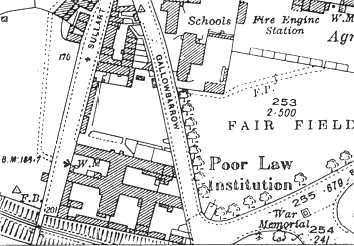
Cockermouth workhouse site, 1923.
The building consisted of a two-storey main block connected at its centre to a cruciform main building at the rear which backed onto the railway .
The workhouse closed in August 1935 and was used by the Royal Army Service Corps during the Second World War. The buildings were demolished in the late summer of 1949.
Ellerbeck Hospital
The former Workington parish workhouse continued to be used for the accommodation of the town's poor until 1853. In 1888, the building, on what is now Ellerbeck Lane, was acquired by Workington Board of Health and converted into a fever hospital. An administrative building was subsequently added to the north of the hospital.
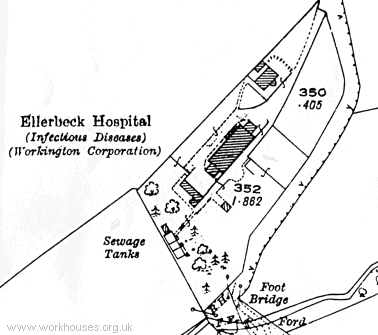
Ellerbeck Hospital site, 1925.
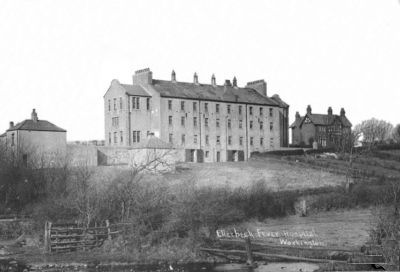
Ellerbeck Hospital from the south
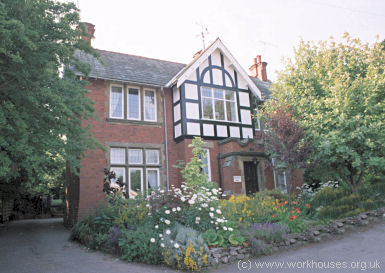
Ellerbeck Hospital former administration building, 2000.
© Peter Higginbotham.
The hospital later became part of Workington Infirmary but closed on 6th December 1965. The hospital has since been demolished and the site redeveloped. The administration building survives as a private house.
Flimby Schools and Park House Children's Home
In addition to the workhouse, the Cockermouth Union opened workhouse schools for 80 children at Flimby in 1887. Flimby Lodge, formerly a ladies' school, was purchased in 1886 for conversion to a school and vagrant wards. In 1914 there were 31 boys and 14 girls in residence.
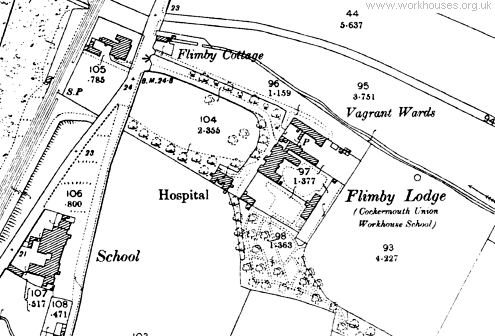
Flimby Schools site, 1900.
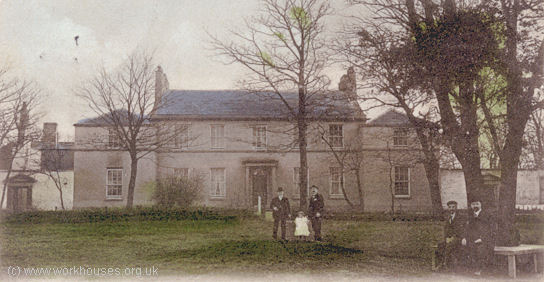
Flimby Lodge, c.1905.
© Peter Higginbotham.
In 1915, Flimby Lodge became a boys-only establishment and the girls were moved to a new home at Park House, 4 North Street, Maryport. Flimby Lodge was closed in 1929 and replaced by Petworth House, Cockermouth.
Keswick Vagrant Wards
In 1891, the union erected additional vagrant wards at Keswick.
Staff
- Cockermouth Workhouse
- Flimby Lodge
- 1914 — Master of Vagrant Wards: Isaac Irving; Matron: Mrs Sarah Irving; Schoolmaster: Robert W Adamson; Schoolmistress: Mrs Sarah Yates; Medical Officer: Robert Lindsay Clark.
Inmates
- Long-term workhouse inmates (1861)
- Cockermouth Workhouse - 1881 Census
- Cockermouth Workhouse - 1891 Census
Records
Note: many repositories impose a closure period of up to 100 years for records identifying individuals. Before travelling a long distance, always check that the records you want to consult will be available.
-
Whitehaven Archive and Local Studies Centre, Scotch Street, Whitehaven, Cumbria CA28 7NL.
- General holdings include: Guardians' minutes (1838-1929); Accounts (1839-1930); Committee minutes (1877-1930); etc.
- Workhouse holdings include: Births and deaths (1842-1933); Admissions and discharges (1902-27); Creed register (1904-33); Punishment book (1864-1917); etc.
- Flimby Lodge holdings include: Register of children (1887-1922); Admissions and discharges (1907-33); Superintendent's report book (1914-16); Report books (1926-1933).
- Park House children's home registers and report books (1915-1931).
Bibliography
- Clarke, James Survey of the Lakes of Cumberland, Westmorland, and Lancashire (1789)
- Higginbotham, Peter The Workhouse Encyclopedia (2014, The History Press)
Links
- None.
Unless otherwise indicated, this page () is copyright Peter Higginbotham. Contents may not be reproduced without permission.


